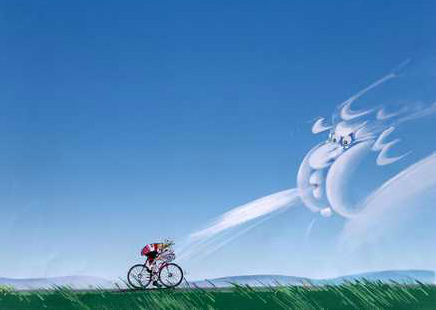
Wind: the perceptible natural movement of the air, especially in the form of a current of air blowing from a particular direction
The National Weather Service (NWS) defines BREEZY as wind sustained at 15 mph and WINDY once winds reach 20 mph or more.
No doubt about it, riding in the wind is hard work. An ordinary breezy day shouldn’t stop us from enjoying a ride. Riding in a strong breeze can be tiring, but it can also make us stronger riders. You won’t be able to maintain your average speed unless you’ve been lucky enough to find the elusive tail wind! That being said, individual tolerance of wind speed varies. So what should we do to have a safe ride when the wind picks up? Here are some tips:
Clothing
Wear form-fitting clothing on windy days. Pull up any zippers. A loose jacket will catch the air like a parachute creating wind resistance. Also keep in mind that wind lowers the temperature (wind chill or RealFeel) so be sure to dress appropriately. A clever piece of equipment is the Cat-Ears Classics Pro helmet strap attachment. Velcro closures attach easily to helmet straps in front of your ears, dampening wind noise while letting traffic sounds or conversation pass through. It will keep your ears warm and enable you to communicate with your cycling partners in the wind.
Body Position
Get low. Assuming a low position using your drop bars to become more compact will lower your center of gravity. This streamlined position will reduce your surface area, wind resistance, and power demand to help you move through the wind. Tuck in your elbows and hug into the bars to increase stability. Bring your knees in as close to the top tube as you can. This makes a “V” shape to slice the wind and force it around your body rather than directly into it.
Bike Handling
Shifting to keep your cadence between 70 and 85 rpm creates a more constant, steady pressure on the pedals and reduces your side-to-side movement. Adjust based on the wind. A bike computer can help you know your speed and cadence.
Riding in the center of the shoulder will allow your bike to be moved to the right or left, going with the gusts rather than fighting them. When a cross wind blows, be ready to lean into the wind. A rearview mirror can help you anticipate when a large vehicle, such as a truck, will be passing you, suddenly blocking the wind and requiring you to adjust how much you are leaning.
Draft. When riding in a group, there is benefit to forming a paceline. You can lower the energy you expend by up to 20% by drafting properly. Even if there are only two riders, taking turns leading (pulling) can conserve the energy of each rider. And when trading pulling duty, keep it short — don’t wait until you’re exhausted to trade off. If pacelining is new to you, the Club offers an in-person clinic each season to members to learn about and practice this crucial skill.
Lastly, never overlap wheels with another cyclist, as a gust of wind could send you sideways and you might take down another rider.
Route Selection
Choose a sheltered route such as a bike path that includes natural windbreaks with hedges, cornfields, buildings, or walls. Avoid hills and stay on the flats. A route with numerous turns will keep you from riding into a headwind for long.
May the wind always be at your back, but if it’s not, this information will help you be better prepared for a gusty ride.
Image from https://velofem.com/2016/01/12/battling-the-wind/
Comments are closed.